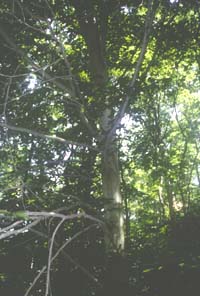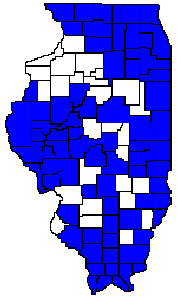 |
| Blue
Beech (Carpinus caroliniana)
Distribution
Map to Right |

Blue beech is also referred to as American hornbeam or musclewood. It is a small tree, 20 to 40 feet tall, with a trunk diameter of up to two feet. The crown is rounded and the trunk is often short and crooked.
Blue beech is widespread throughout Illinois in wet-mesic forests. It is native to most of the eastern United States with the exception of the southern two-thirds of Florida, areas of the Gulf Coast, and the Mississippi River bottomland south of Missouri to the gulf. It tolerates a wide variety of conditions, but grows best on wet-mesic, rich soils. It doesn't tolerate flooding very well, and requires soils that drain or are unsaturated.
Interesting
Facts
Blue beech has a smooth, gray trunk that has the sinewy appearance of flexed muscles, hence the common name "musclewood." The common name hornbeam arises from the fact that long ago, related European trees were used in the manufacture of yokes for oxen. The latin "carpinus" probably comes from "carpentum," meaning a Roman horse-drawn wagon with hard, wooden wheels.
American hornbeam is a slow growing tree that typically occurs as an understory species. It is primarily a secondary tree, rarely a dominant. It occurs in mesic and wet mesic forests with white oak, black oak, pin oak, sweetgum, cherrybark oak, American elm, hop hornbeam, flowering dogwood, sugar maple, and blue ash, to name just a few associated trees. It often occurs in habitats (for example, a transitional forest changing from mesic to wetter forest types). Even though blue beech leaves are of average or low nutrient content, they enrich the litter/soil because major plant nutrients such as nitrogen and phosphorus remain in the leaves when they are shed.
Identifying Features
BarkUses
Blue beech bark is smooth and blue-gray with ridges reminiscent of muscles.
Twigs
The twigs are reddish brown and strong, smooth or with only sparse hairs. The buds are small, angle sharply away from the twig (lateral buds) and have pointed tips.
Leaves
The leaves are alternate and simple, from 2-4 inches long and 1-2 inches broad. They are finely or doubly toothed at the edges, taper to a pointed tip and are rounded at the base. The upper surface of the leaf is smooth and the underside may be hairy or smooth. The leafstalks are up to 1/2 inch long and hairy.
Flowers
Blue beech is moneocious (both male and female flowers on the same tree, but in different catkins) and flowers in April.
Fruits
The fruits are tiny nutlets, at the base of a three-pointed leaf-like structure (bract) and ripen in August - October.
Blue beech wood is strong and hard, but because the tree is so small, it is rarely harvested for the manufacture of wood products. Nevertheless, it is useful for tool handles, levers, and mallets. Blue beech is an important food source for gray squirrels in bottomland hardwood forests. Game birds also eat its seeds, buds, and catkins.